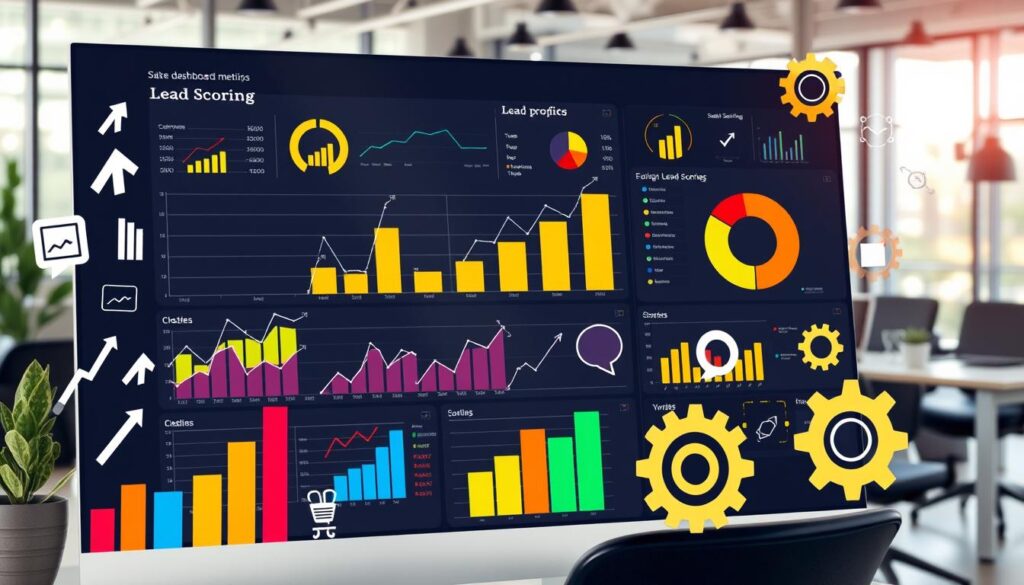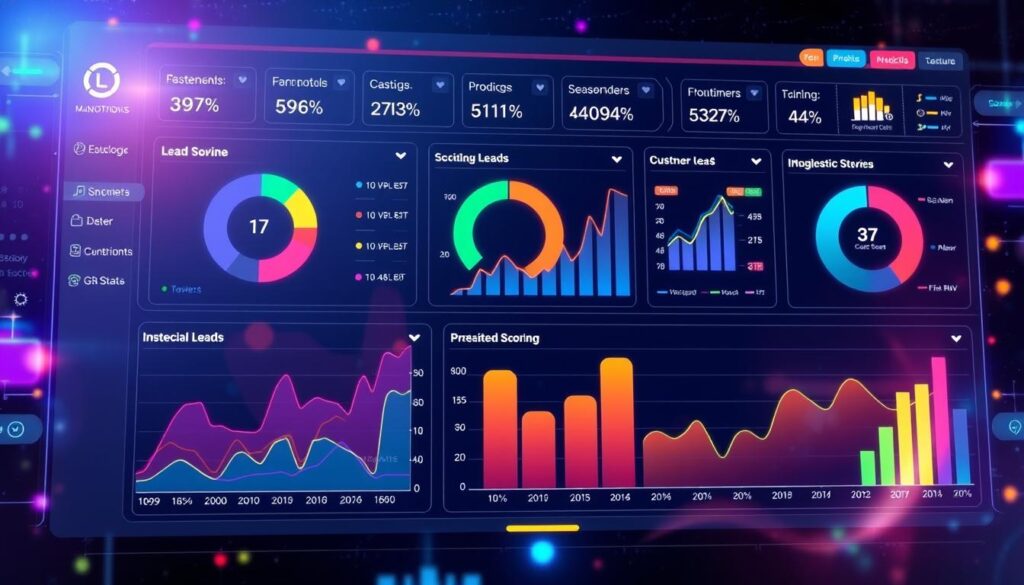The rise of predictive lead scoring has been a game-changer for businesses fine-tuning their sales strategies. By applying machine learning and artificial intelligence, companies can now sort huge amounts of data. They can pinpoint which leads are most likely to convert.
Studies show 62% of marketers use artificial intelligence. It plays a crucial role in making teams more efficient and in sync.
Constant innovation is key, say 91% of Chief Marketing Officers. Automated lead scoring provides a competitive edge, with 98% of sales teams acknowledging AI’s impact on lead prioritization. Predictive analytics pinpoint each lead’s value, guiding where to focus efforts and how to engage potential customers.
Salesforce’s Einstein Lead Scoring keeps scores updated, reflecting market changes every 10 days. Moreover, 86% of IT leaders praise generative AI. It can create multiple email drafts quickly—a task that used to take hours.
Key Takeaways
- Generative AI’s pivotal role, with an 86% endorsement by IT leaders, heralds a new era of efficiency in business operations.
- Logistic regression and purchase intent models are instrumental in forecasting conversion rates through predictive lead scoring.
- Automated lead scoring software like Salesforce’s Einstein underscores the systematic advancements in lead management.
- Despite robust scoring mechanisms, 70% of leads may still not be immediately ready to purchase, necessitating nuanced sales strategies.
- Negative scoring attributes serve as valuable counterbalances in evaluating lead potential within predictive lead scoring models.
Understanding Predictive Lead Scoring
In today’s data-driven world, predictive lead scoring is key. It lets businesses rank potential leads by their chances to become sales. This uses predictive modeling for lead generation, making marketing more focused and efficient.
Definition and Importance
This approach blends machine learning lead scoring with analysis of many data points, like demographics and customer actions. It gives each lead a score to show its potential as a customer. With this, companies can better focus on likely customers, boosting sales.
Using lead qualification software helps make sales smoother and more accurate. Predictive lead scoring’s power lies in uncovering insights beyond traditional methods. This helps target efforts more effectively.
Key Components of Lead Scoring
Effective scoring relies on several key parts. First, machine learning algorithms analyze big data to spot patterns. For example, HubSpot uses this tech to predict likely converts within 90 days.
Good data is also crucial. For accurate modeling, data must be up-to-date and well-managed. Wrong data can lead to false leads. Keeping scores updated with new insights is essential for keeping up with changing trends.
Predictive modeling improves lead handling and the customer journey. It lets firms personalize their outreach. Using advanced scoring, businesses can market more effectively, a must in competitive arenas.
The Benefits of Predictive Lead Scoring
The arrival of predictive lead scoring tools has started a new age in customer interaction and sales strategies. These tools help businesses greatly improve their conversion rates. They also make sales processes smoother.

At the heart of this change is AI lead scoring. It uses advanced algorithms to gauge if a lead will become a customer. This is different from old ways that scored leads by basic info. Predictive models use lots of data, including behavior, giving a full view of each potential client.
Increased Sales Efficiency
Predictive lead scoring greatly boosts sales efficiency. It helps sales teams focus on the most promising leads. This optimizes their efforts and resources.
Knowing which leads are likely to buy helps prioritize engagement. This could shorten the sales cycle and increase profits.
Enhanced Customer Insights
This technology also provides better customer insights. It analyzes data like online behavior and engagement patterns. This lets businesses understand their customers’ needs more deeply.
This deeper understanding leads to more personalized customer interactions. It builds stronger relationships and boosts customer happiness.
Pairing AI technologies with CRM systems, like Salesforce’s Einstein, gives businesses up-to-date lead scores. These scores not only refine sales strategies but also give a competitive advantage. Predictive models rely on datasets from various sources, ensuring sales teams have precise and useful information.
Even though predictive lead scoring tools need lots of data and constant updates, the payoff is worth it. The increase in conversion rates and sales efficiency makes it an essential tool for businesses wanting to excel.
Implementing Predictive Lead Scoring
Adding predictive lead scoring to CRM systems is key for improving sales strategies. It makes lead management better and helps marketing and sales teams work together. Knowing how to mix it into your system and deal with data helps avoid usual mistakes.
Steps for Integration with Existing CRM
To add predictive lead scoring, make sure your CRM can work with new models. Modern CRM platforms offer real-time scoring. This updates lead scores in minutes, unlike older methods that take a day. For example, Sales Cloud makes adding predictive lead scoring easy with tools like the ‘My Open Leads Scored’ view, showing lead scores and trends.
Best Practices for Data Management
Good data management is key for predictive lead scoring’s success. You must keep data quality high and update models regularly. This reflects the latest market and customer trends. Using visual tools like the Lead Score Widget helps sales teams see what affects lead scores.
For predictive lead scoring, using various types of data is necessary. This includes info on demographics, past interactions, and current behaviors. It helps create a strong model predicting how likely a lead will become a real chance.
Common Pitfalls to Avoid
Predictive lead scoring has great benefits but comes with challenges. Relying too much on automation and not enough on human insight is a big mistake. It can make you read data wrong. Not fully using the system’s features is often because teams don’t get how it works or its benefits.
To dodge these problems, continuous training and valuing human judgement is key. It’s important to keep up with sales analytics and use what they show. This ensures you get the most out of predictive lead scoring.
Summing up, using predictive lead scoring in CRM systems improves lead handling and boosts sales, making it a smart choice for increasing sales effectiveness and ROI.
Technologies Behind Predictive Lead Scoring
Tools for predictive lead scoring mark a big leap in tech and sales strategies. They’re powered by machine learning and data analytics. These are key in changing how we manage leads.
Machine Learning Algorithms
Machine learning gives predictive lead scoring its power. It analyzes big datasets to spot patterns we’d miss. This helps businesses predict which leads will likely become sales.
Such tech is vital for staying ahead. It lets companies use their resources smarter and boost sales.
Data Analytics Tools
Data analytics is crucial for predictive lead scoring. It looks into past data to find what buyers like and don’t like. Using this, companies can better score leads and find the best ones.

With tools like MadKudu, companies can see a big jump in lead conversions. Predictive lead scoring also cuts marketing costs by focusing on the most promising leads.
Using platforms like Dynamics 365 Sales, businesses can score a lot of leads each month. This tech helps marketing pros manage leads without much IT help.
Predictive lead scoring changes the game. It saves time, cuts costs, and targets marketing better. As tech and sales strategies grow together, they’re creating a new way businesses meet potential customers.
Measuring Success with Predictive Lead Scoring
To measure the predictive lead scoring efficacy, focus on Key Performance Indicators (KPIs). It’s essential to refine sales strategies optimization regularly. Predictive lead scoring improves conversion rates when integrated into sales systems.
Key Performance Indicators (KPIs)
Choosing the right KPIs is key for predictive lead scoring success. Important metrics include conversion rates, lead score distribution, and average lead score by source. These indicators show how the system boosts sales and how well it ranks leads.
Adjusting Strategies Based on Outcomes
Teams make smarter choices by examining predictive lead scoring results. After studying KPIs, they tailor their methods to market trends and customer needs. This boosts sales strategies optimization.
By analyzing outcomes, companies can adapt their sales plans for better campaign and customer acquisition outcomes. Regular updates to lead scoring models help them stay current with market changes. This leads to ongoing improvements.
| Predictive Lead Scoring | Traditional Lead Scoring |
|---|---|
| High data utilization | Low data involvement |
| Machine-based assessment | Human-based assessment |
| Complex algorithms | Simpler models |
| High accuracy levels | Variable accuracy |
The value of predictive lead scoring lies in real growth in conversion rates and customer happiness. Success comes from constantly improving sales processes with good data, technology, and flexible strategies.
Future Trends in Predictive Lead Scoring
Predictive lead scoring is quickly transforming sales and marketing. It’s powered by AI lead scoring and automated lead scoring. This change is more than just new technology. It’s reshaping how we generate leads. By 2024, AI will vastly enhance predictive modeling for lead generation. Tools like SalesMind AI, HubSpot, and Salesforce Einstein will lead the way. They use machine learning to predict if a prospect will likely convert. This is a more powerful method than older ways.
The Role of AI and Automation
AI is changing how lead scoring works. It improves accuracy and automates processes. Salesforce Einstein weds AI deep into CRM systems. It creates scoring models that match specific business goals. According to Salesforce’s State of Sales Report, 98% of teams using AI see better lead prioritization. But, to fully benefit from AI, sales, marketing, and data teams must work together. This teamwork ensures effective data use and protection.
Evolving Customer Expectations
Customer needs are always changing. This makes predictive lead scoring and following lead scoring best practices key to success. In today’s world, personalization is everything. Predictive tools provide that edge to create custom experiences. The predictive Lead Scoring Software Market will grow from USD 1.5 Billion in 2022 to USD 5.2 Billion by 2030. This growth shows how vital predictive lead scoring is. By blending AI smarts with human insight, teams can better manage lead scoring challenges.
FAQ
What is predictive lead scoring and how does it boost sales success?
Predictive lead scoring is a method that ranks leads based on their potential to become customers. It uses predictive analytics and machine learning. This process helps sales teams concentrate on promising leads. This improves conversion rates and sales strategies.
What are the key components of lead scoring?
The main parts of lead scoring include demographic info, lead behavior, and social engagement. Interaction data and AI may also play a role. Algorithms analyze this data to prioritize leads for sales teams.
How does predictive lead scoring increase sales efficiency?
Predictive lead scoring makes the lead qualification process faster and more accurate. It helps sales teams quickly identify the most promising leads. This reduces time spent on leads less likely to convert.
What enhanced customer insights can predictive lead scoring provide?
It offers insights into customer behavior and preferences. These insights help tailor communication strategies. This leads to personalized interactions and better customer relationships.
What are the steps for integrating predictive lead scoring with an existing CRM?
Steps include selecting a compatible scoring tool and ensuring your data is clean. Then, set scoring parameters based on goals, and train your team on the results.
What are some best practices for data management in predictive lead scoring?
Maintain high-quality data and regularly update your models. Ensure the scoring reflects latest lead behavior trends.
What are common pitfalls to avoid when implementing predictive lead scoring?
Avoid relying too much on technology without sales team input. Update the model to reflect recent data regularly. And use the tool’s full capabilities.
Which machine learning algorithms are used in predictive lead scoring?
Algorithms like logistic regression, decision trees, and neural networks are used. They predict sales potential using past conversion data.
How are data analytics tools utilized in predictive lead scoring?
Data analytics tools process and analyze lead data. They identify patterns to improve the model’s accuracy and effectiveness.
What KPIs are important for measuring the success of predictive lead scoring?
Important KPIs include conversion rates, score accuracy, and impact on sales revenue. These measure the success of predictive lead scoring.
How should sales strategies be adjusted based on predictive lead scoring outcomes?
Adjust strategies by focusing on higher-score leads. Refine engagement tactics and improve the scoring model based on actual conversions.
What is the role of AI and automation in the future of predictive lead scoring?
AI and automation will refine lead scoring models with real-time updates. This allows for personalized communication and efficient lead qualification.
How are evolving customer expectations shaping predictive lead scoring?
Customers expect personalized and relevant interactions. Predictive lead scoring helps meet these expectations by tailoring sales strategies effectively.



